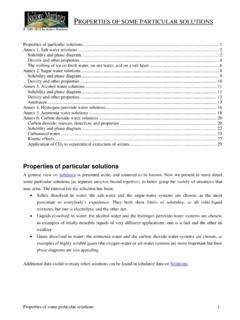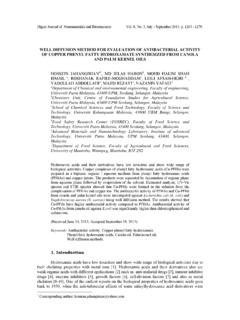Transcription of Electrocoagulation in the treatment of industrial …
1 VISIONS SCIENCE TECHNOLOGY RESEARCHHIGHLIGHTSD issertation 19 VTT SCIENCE 19 Electrocoagulation in the treatment of industrial waters and wastewatersISBN 978-951-38-7940-2 (soft back ed.) ISBN 978-951-38-7941-9 (URL: )ISSN 2242-119X (soft back ed.) ISSN 2242-1203 (URL: ) Electrocoagulation in the treatment of industrial waters and wastewaters Chemical coagulation is commonly used in raw water and wastewater treatment plants for the destabilisation of pollutants so that they can be removed in the subsequent separation processes. The most commonly used coagulation chemicals are aluminium and iron metal salts.
2 Electrocoagulation technology has also been proposed for the treatment of raw waters and wastewaters. With this technology, metal cations are produced on the electrodes via electrolysis and these cations form various hydroxides in the water depending on the water pH. In addition to this main reaction, several side reactions, such as hydrogen bubble formation and the reduction of metals on cathodes, also take place in the cell. In this research, the applications of Electrocoagulation were investigated in raw water treatment and wastewater in the treatment of industrial waters and wastewatersMikko Veps l inen VTT SCIENCE 19 Electrocoagulation in the treatment of industrial waters and wastewaters Mikko Veps l inen Thesis for the degree of Doctor of Science (Technology)
3 To be presented with due permission for public examination and criticism in chamber music audito-rium at the Concert and Congress House Mikaeli, Mikkeli, Finland on the 2nd of November, 2012 at noon. ISBN 978-951-38-7940-2 (soft back ed.) ISSN 2242-119X (soft back ed.) ISBN 978-951-38-7941-9 (URL: ) ISSN 2242-1203 (URL: ) Copyright VTT 2012 JULKAISIJA UTGIVARE PUBLISHER VTT PL 1000 (Tekniikantie 4 A, Espoo) 02044 VTT Puh. 020 722 111, faksi 020 722 7001 VTT PB 1000 (Teknikv gen 4 A, Esbo) FI-2044 VTT Tfn. +358 20 722 111, telefax +358 20 722 7001 VTT Technical Research Centre of Finland Box 1000 (Tekniikantie 4 A, Espoo) FI-02044 VTT, Finland Tel.
4 +358 20 722 111, fax +358 20 722 7001 Kopijyv Oy, Kuopio 2012 3 Electrocoagulation in the treatment of industrial waters and wastewaters Mikko Veps l inen. Espoo 2012. VTT Science 19. 96 p. + app. 50 p. Abstract Chemical coagulation is commonly used in raw water and wastewater treatment plants for the destabilisation of pollutants so that they can be removed in the sub-sequent separation processes. The most commonly used coagulation chemicals are aluminium and iron metal salts. Electrocoagulation technology has also been proposed for the treatment of raw waters and wastewaters.
5 With this technology, metal cations are produced on the electrodes via electrolysis and these cations form various hydroxides in the water depending on the water pH. In addition to this main reaction, several side reactions, such as hydrogen bubble formation and the reduction of metals on cathodes, also take place in the cell. In this research, the applications of Electrocoagulation were investigated in raw water treatment and wastewater applications. The surface water used in this research contained high concentrations of natu-ral organic matter (NOM).
6 The effect of the main parameters current density, initial pH, electric charge per volume, temperature and electrolysis cell construc-tion on NOM removal were investigated. In the wastewater treatment studies, the removal of malodorous sulphides and toxic compounds from the wastewaters and debarking effluents were studied. Also, the main parameters of the treatment , such as initial pH and current density, were investigated. Aluminium electrodes were selected for the raw water treatment , whereas wastewaters and debarking effluent were treated with iron electrodes.
7 According to results of this study, aluminium is more suitable electrode material for Electrocoagulation applications because it produces Al(III) species. Metal ions and hydroxides produced by iron electrodes are less effective in the destabilisation of pollutants because iron electrodes produce more soluble and less charged Fe(II) species. However, Fe(II) can be effective in some special applications, such as sulphide removal. The resulting metal concentration is the main parameter affecting destabilisation of pollutants. Current density, treatment time, temperature and electrolysis cell construction affect the dissolution of electrodes and hence also the removal of pollutants.
8 However, it seems that these parameters have minimal significance in the destabilization of the pollutants besides this effect (in the studied range of parameters). Initial pH and final pH have an effect on the dissolution of electrodes, but they also define what aluminium or iron species are formed in the solution and have an effect on the -potential of all charged species in the solution. According to the results of this study, destabilisation mechanisms of pollutants by Electrocoagulation and chemical coagulation are similar.
9 4 Optimum DOC removal and low residual aluminium can be obtained simultane-ously with Electrocoagulation , which may be a significant benefit of electrocoagula-tion in surface water treatment compared to chemical coagulation. Surface water treatment with Electrocoagulation can produce high quality water, which could be used as potable water or fresh water for industrial applications. In wastewater treatment applications, Electrocoagulation can be used to precipitate malodorous sulphides to prevent their release into air. Technology seems to be able to remove some toxic pollutants from wastewater and could be used as pretreatment prior to treatment at a biological wastewater treatment plant.
10 However, a thorough eco-nomic and ecological comparison of chemical coagulation and Electrocoagulation is recommended, because these methods seem to be similar in pollutant destabilisa-tion mechanisms, metal consumption and removal efficiency in most applications. Keywords Electrocoagulation , water treatment , wastewater treatment 5 Preface This study was carried out between 2006 and 2011 at the Laboratory of Green Chemistry, Mikkeli, Finland with financial support from the European Union, the City of Mikkeli, Savcor Forest Oy and UPM-Kymmene Oyj.











